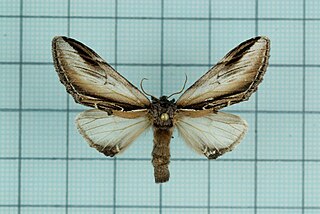Related Research Articles

Isognathus rimosa, the rimosus sphinx, is a moth of the family Sphingidae. The species was first described by Augustus Radcliffe Grote in 1865. It is known from tropical climates from northern Brazil north through Central America, the West Indies and Mexico to southern Arizona.

Aglaia rimosa is a species of plant in the family Meliaceae. It is found in Indonesia, Papua New Guinea, the Philippines, and Taiwan.

Isognathus is a genus of moths in the family Sphingidae.

Pheosia rimosa, the black-rimmed prominent moth, fissured prominent or false-sphinx, is a moth of the family Notodontidae. The species was first described by Alpheus Spring Packard in 1864. It is found from coast to coast in North America, although it is less common in the south-eastern United States.

Onciderini is a tribe of longhorn beetles of the subfamily Lamiinae, they are prevalent across Europe in nations such as Turkey, and Finland.
Hypsioma is a genus of longhorn beetles of the subfamily Lamiinae, containing the following species:
Hypsioma amydon is a species of beetle in the family Cerambycidae. It was described by Dillon and Dillon in 1945. It is known from Brazil, Peru and Ecuador.
Hypsioma aristonia is a species of beetle in the family Cerambycidae. It was described by Dillon and Dillon in 1945. It is known from Brazil.
Hypsioma attalia is a species of beetle in the family Cerambycidae. It was described by Dillon and Dillon in 1945. It is known from Brazil.
Hypsioma chapadensis is a species of beetle in the family Cerambycidae. It was described by Dillon and Dillon in 1945. It is known from Brazil and Paraguay.
Hypsioma charila is a species of beetle in the family Cerambycidae. It was described by Dillon and Dillon in 1945. It is known from Brazil.
Hypsioma hezia is a species of beetle in the family Cerambycidae. It was described by Dillon and Dillon in 1945. It is known from Paraguay, Brazil and Argentina.
Hypsioma lyca is a species of beetle in the family Cerambycidae. It was described by Dillon and Dillon in 1945. It is known from Brazil, Colombia, Ecuador and Peru.
Hypsioma nesiope is a species of beetle in the family Cerambycidae. It was described by Dillon and Dillon in 1945. It is known from Colombia and Panama.
Hypsioma opalina is a species of beetle in the family Cerambycidae. It was described by Dillon and Dillon in 1945. It is known from Brazil.
Hypsioma robusta is a species of beetle in the family Cerambycidae. It was described by Dillon and Dillon in 1945. It is known from Brazil.
Hypsioma steinbachi is a species of beetle in the family Cerambycidae. It was described by Dillon and Dillon in 1945. It is known from Bolivia and Brazil.
Hypsioma viridis is a species of beetle in the family Cerambycidae. It was described by E. Forrest Gilmour in 1950. It is known from Brazil.
Dalbergia rimosa is a species of liana, with the Vietnamese name trắc giây or trắc dây. The synonym Dalbergia discolor, with the Vietnamese name trắc biến màu, is no longer recognised. The genus Dalbergia is placed in the subfamily Faboideae and tribe Dalbergieae.

Okanagana rimosa, or Say's cicada, is a species of cicada in the family Cicadidae. It is found in North America. the larvae live for strictly four years.
References
- ↑ BioLib.cz - Hypsioma rimosa. Retrieved on 8 September 2014.